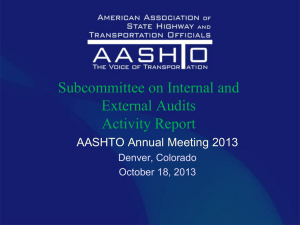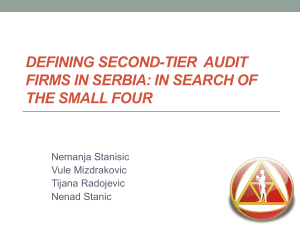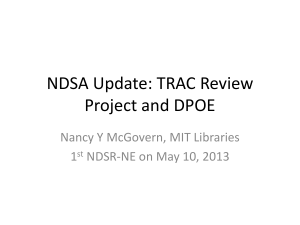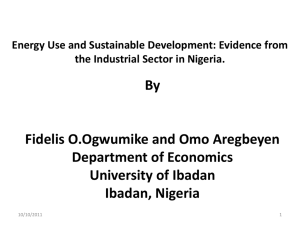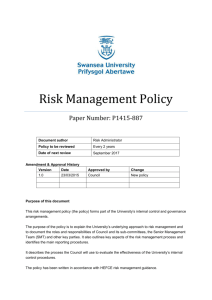effective risk management - Association of Financial Mutuals
advertisement
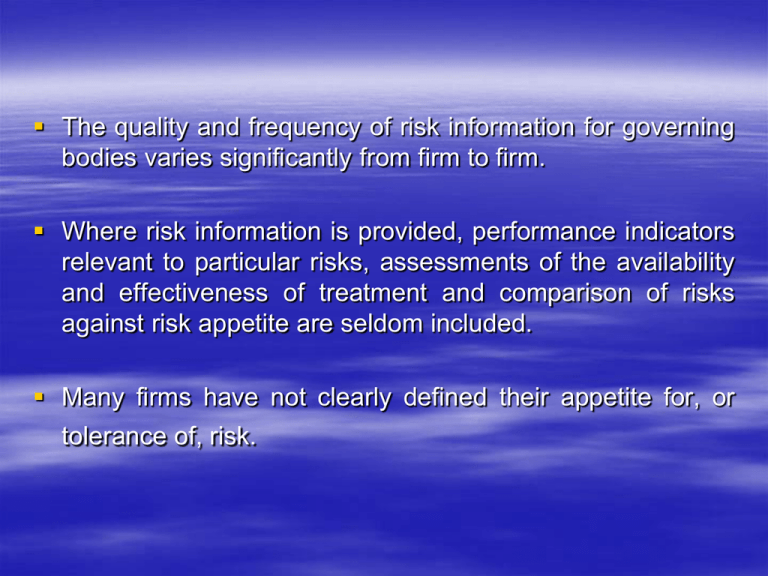
The quality and frequency of risk information for governing bodies varies significantly from firm to firm. Where risk information is provided, performance indicators relevant to particular risks, assessments of the availability and effectiveness of treatment and comparison of risks against risk appetite are seldom included. Many firms have not clearly defined their appetite for, or tolerance of, risk. The banking crisis and the economic environment has further highlighted the importance of firms having in place effective risk management controls driven by firms senior management. Over the last 12 months there have been various regulatory and European reports & publications on this matter for example: Walker Report; A review of corporate governance in UK banks and other financial industry entities, quote from report: ‘Firms should satisfy themselves on the integrity of its risk management controls and that they are robust and defensible’ CEIOPS’’ Advice for Level 2 Implementing Measures on Solvency II: System of Governance Synopsis ‘A clearly defined and well documented risk management strategy that includes the risk management objectives, key risk management principles, general risk appetite and assignment of risk management responsibilities across all the activities of the undertaking and is consistent with the undertaking’s overall business’ ‘Effective Corporate Governance (Significant influence controlled functions and Walker Review) Policy Statement (PS) September 2010’ A new framework of classification of controlled functions NED holding a Chairman role will be reclassified: CF2a (Chairman) CF2b (Senior independent director) CF2c (Chairman of risk committee) CF2d (Chairman of audit committee) CF2e (Chairman of remuneration committee) Chair of Risk/Audit/Remuneration Committees The FSA comment that they would not preclude executive directors from performing the role of chairperson for firms risk/audit/remuneration committees, where that is deemed appropriate in the circumstances of the firm, however they would expect this to be in exceptional circumstances only and for these functions typically to be filled by a NED. Finance, Audit & Risk (CF28) The CF28 function will be spilt into three distinct functions finance, risk and internal audit – CF 13, 14, and 15 respectively. Internal Audit Function FSA adding further guidance to SUP 10 to make it clear that they expect the person responsible for CF15 not to be responsible for another governing function Additionally the FSA acknowledge the role of today’s internal audit function and are amending SUP 10.8.3 R to include a requirement that the internal audit function reports on the effectiveness of the firm’s systems of internal control. Outsourcing of CF 13 (Finance) & CF15 (Internal Audit) A third-party service provider may be used to help a firm fulfil a particular task or activity but cannot be in a position of significant influence – that can only be a person at a firm. For example, if a firm’s internal audit function has been outsourced, the person carrying out the internal audit function (CF15) would normally be the person responsible for that function to the governing body or in larger firms to the audit committee. The Walker Review - effective risk management Risk Committee Where no risk committee exists, there should, however, still be someone accountable for risk at the firm and the governing body will retain responsibility for risk oversight. Chief Risk Officer (CRO) FSA expectation is that CRO will challenge and alert the board in instances where it is seeking to act beyond its already agreed risk appetite/tolerances.





